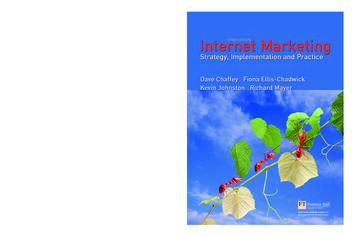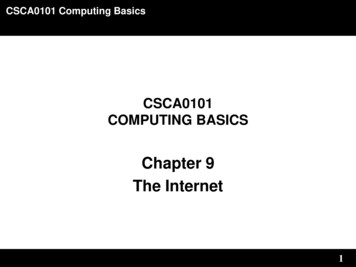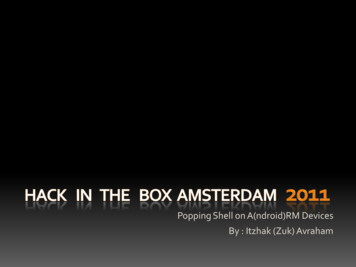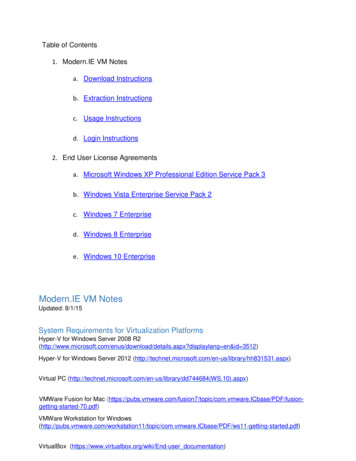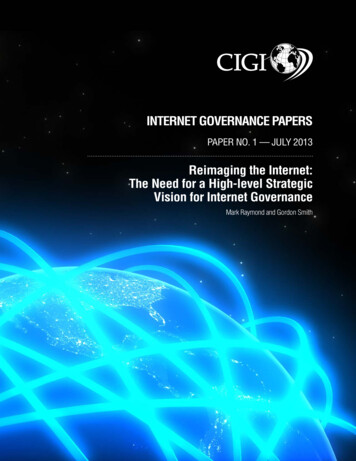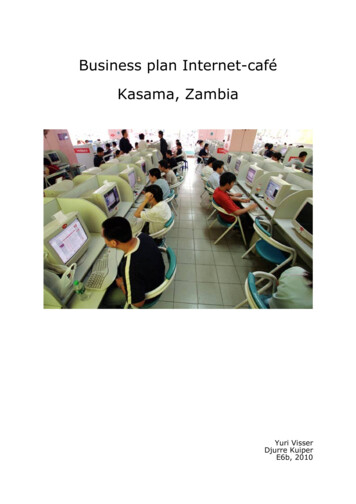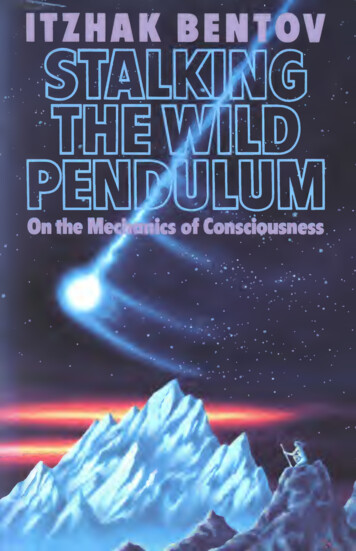
Transcription
ITZHAK BIMiOMOn the Mecpmfft of Consciousness
StalkingThe WildPendulumOn the Mechanics of ConsciousnessITZHAK BENTOVBOOKSDestiny BooksRochester, Vermont
Destiny BooksOne Park StreetRochester, Vermont 05767www.InnerTraditions.comDestiny Books is a division of Inner Traditions InternationalFirst Quality Paperback edition 1988 by Destiny BooksCopyright 1977 Itzak BentovCopyright 1988 Mirtala BentovAll rights reserved. No part of this book may be reproduced or utilized in any form or byany means, electronic or mechanical, including photocopying, recording, or by any in formation storage and retrieval system, without permission in writing from the publisher.Library of Congress Cataloginc-in-Pijblication DataBentov, Itzak.Stalking the wild pendulum : on the mechanics of consciousness by ItzakBentov.p.cm.Originally published: New York : E. P. Dutton, 1977.Bibliography: p.ISBN 0-89281-202-81. Consciousness. 2. Cosmology.BF311.B453 1988I. Title.126—del 987-36458Printed and bound in the United States2019181716151413121110
ACKNOWLEDGEMENTSDuring the time that this book was written, I conferred withmany people, mostly scientists who are specialists in theirrespective fields, to check out the details of my ideas. Thisfact does not imply in any way that all of them agree withthe material presented here.First, I would like to express my gratitude to ProfessorMael Melvin, physicist at Temple University, for going overthe manuscript and straightening out my physics, whichwas limping in places; and to Professor William W. Tiller,Materials Sciences Department, Stanford University, forour long discussions about the nature of the universe andfor his writing a preface to this book. To Tom Etter,physicist, University of Minnesota, for our discussions ofthe pre-quantum states.Many thanks to all my friends, who kept urging me towrite this book, starting with Lee Sannella, M.D., whoarranged for the first public presentation of these ideas; toRichard Ingrasci, M.D., Eddie Hauben, Bill and TomHickey, and the rest of my friends at "Interface,” who keptthings moving. To my friends at Whitewood-Stamps, Jes sica Lipnack, Tom Nickel, Jeff Stamps, and Frank White,all knowers of the relative and the absolute, who gave aninitial criticism of the manuscript; to Paul Nardella, theelectronics wizard, who designed and built the electronicinstruments used in our measurements and experiments; toDavid Doner, M.D., who helped with the medical portion ofthe appendix; to Robert L. Schwartz, chairman, TarrytownConference Center, who arranged for the presentation of
these ideas for criticism to a panel of scientists; and finally,to my wife Mirtala, who patiently edited, criticized, andtyped the manuscript.Itzhak BentovIllustrated by the author, except for some of the better looking sketches, which were done by Rick Humesky ofAnn Arbor, Michigan.PUBLISHER'S NOTEAn outstanding exponent of the new science of con sciousness, Itzhak Bentov touched all whom he encounteredwith his insightfulness and genius of expression. His untimelydeath in 1979 was an undeniable loss, but his vision—clearlypresented and accessible in his writings—continues to illuminethe forward path to higher consciousness.
CONTENTSPreface by William A. TillerIntroduction11.Sound, Waves and Vibration92.A Look Through a Supermicroscope3.A Morse Code of Action and Rest4.An Experiment with Time5.Quantity and Quality of Consciousness6.Relative Realities7.The Parable of the Bicycle8.A Model of the Universe9.The “How to” of Intuitive Knowledge4557117126159169Appendix: Stresses and the BodyIntroduction779310. Some Reflections on the CreatorEpilogue32171172The Physio-kundalini SyndromeAppendix Bibliography194174145
Dedicated to those individualswho are trying to pull together diverse aspectsof nature into one new, meaningful whole .
PREFACEIt is with a great sense of pleasure that I write this preface tothe first book by my remarkable friend, Itzhak Bentov, whois known to all as Ben.Ben is an intuitive inventor without much formal educa tion who likes to tinker about in his versatile basementlaboratory seeking simple and practical solutions to com plex technological problems. Presently, he spends most ofhis time developing a variety of medical instruments. Thisis how he makes his living, and he is sufficiently good at it tobe in great demand by modern, specialized industries thatdesperately need his special brand of creativity.On one of my visits to his home, I noticed on one of thebook shelves of his rather extensive technical and scientificlibrary a little book with a pink cover, titled Winnie ThePooh, tucked away between heavy books with ponderoustechnical titles. This may give some insight into the whimsi cal style used by Ben throughout this book.His intuition led him into the regular practice of medita tion about ten years ago, which, in turn, led to enhancedpersonal integration and internal coherence. This was fol lowed by the design of experiential journeys into the micro cosm and macrocosm of the universe; collectively, out of itall has flowed this beautiful little book. It is a really finebook, easy to read and worthy of the attention of all, old andyoung, who want to expand their awareness and grow inconsciousness. It is also a most useful model for the develop ment of our future science.The present scientific establishment has grown some what fossilized by its current “world picture” and is locked
into a view of reality that has outlived its usefulness. It hasbegun to limit mankind’s growth and has so increased itssense of specialization, separateness, materiality, andmechanical computerlike functioning that it is in realdanger of self-extermination. Its sense of wholeness and pur pose has been severely fragmented as our egos have reveledin the individual power created by ownership of physicalscientific knowledge. We desperately need to find a pathback to wholeness!This recent period of quantitative physical science hasbeen extremely important to humankind’s developmentsince it has forged a clearly discernible, albeit materialistic,path through the uncharted terrain of Nature’s expression.It has taught us how to perform meaningful, reproducibleexperiments and to build and test relevant theories aboutNature. However, we have presently become so focused onthis one path that we have lost the flexibility of sensing allthe other possible paths of knowledge available to us in thewonderland of Nature.We have come to think that the renowned “scientificmethod” is to be coldly objective about an experimentbecause that has been very effective for much of the pastexperimentation. However, the scientific method is really“to provide the necessary and sufficient protocol for any one, anywhere, to successfully duplicate the experimentalresult.” If this requires a positive, negative, or neutral men tal or emotional bias, then so be it. As we move off the purelyphysical path in our future experimentation, we will needto include, clearly define, and quantitatively measure thesestates of bias because we shall find that the human mind andhuman intention alter the very substratum in which ourphysical laws operate.Our physical science does not necessarily deal with real ity, whatever that is. Rather, it has merely generated a set ofconsistency relationships to explain our common ground ofexperience, which is determined, of course, by the capacityand capabilities of our physical sensory-perception mechan isms. We have developed these mathematical laws based ulti mately on a set of definitions of mass, charge, space, andtime. We don’t really know what these quantities are, but we
have defined them to have certain unchanging propertiesand have thus constructed our edifice of knowledge on thesepillars. The edifice will be stable so long as the pillars areunchanging. However, we appear to be entering a period ofhuman evolvement in which certain qualities of the humanbeing appear to be able to change, or deform, these basicquantities. Thus, our set of laws or consistency relation ships will have to change to embrace this new experience. Itisn’t as if the old laws are wrong and need to be thrown out— no more than Newton was wrong when Einstein camealong and showed that the laws of gravitation had to bealtered when one adopted a frame of reference for observa tion that moved at velocities approaching the velocity oflight. At this time, we are beginning to adopt new states ofconsciousness as reference frames for observing Nature, andthus the old laws will need to be altered to conform with thenew experience, when the experiential sensing is suffic iently widespread as to constitute a common ground of expe rience. Along this path, humankind’s view of itself, of theuniverse, and of the synergistic interrelationship of both isin for great changes!There have been some small beginnings made toward anew “self image” for humankind, one that emphasizes thehuman wholeness and connectivity with everything aroundit. Everything seems to interact with everything else at manysubtle levels of the universe beyond the purely physicallevel, and the deeper we penetrate into these other levels, themore do we realize that we are One.This book takes a great step forward by simply articulat ing that fact — thus contributing to the understanding ofour future development.WilliamA.Tiller
STALKING THE WILD PENDULUM
INTRODUCTIONThis book is the result of some living-room discussions thatI had with friends over a period of time. They became moreand more elaborate as topics were added to the original dis cussions. Eventually, my friends felt that presenting theseideas to a broader audience would be in order. Finally, Igave in to the well-intentioned nagging of my friends andput down some of these ideas on paper.As I sat down to write, I wondered whether it was the righttime to do so. The accumulation of knowledge is a continu ous process, and it is difficult to say at what point oneshould say: “Stop here and write down whatever informa tion has accumulated up until now.” I have decided to startwriting at my present level of ignorance simply because thecircumstances forced me to do so. It is certain that I coulddescribe many things better and add many new ideas if Iwere to start this book two or three years from now. How ever, I would still face the same situation because one’s levelof ignorance increases exponentially with accumulatedknowledge. For example, when one acquires a bit of newinformation, there are many new questions that are gener ated by it, and each new piece of information breeds five orten new questions. These questions pile up at a much fasterrate than does the accumulated information. The more oneknows, therefore, the greater his level of ignorance. Thiseffect does seem to justify my decision to publish this infor mation now.Therefore, I do not claim that the information containedhere is the final truth, but I hope that it will stimulate morethinking and speculation by future scientists and interestedlaymen.
2STALKING THE WILD PENDULUMMuch of this information has come through intuitiveinsight, which is no justification, of course, for omitting arational support for this material. When we come to thedescription of the “shape” of the universe and the process ofits creation, however, a rational support becomes tenuoussince we are dealing with material that cannot be fully sup ported yet by scientific facts. Here the principal guide forjudging the material presented is one’s intuition or subjec tive experience.This book is designed for young people of all ages, bywhich I mean those whose imagination has not been stifledby the standard educational process. It is written for peoplewho can still be awed by the way ants build their burrows,by the cold elegance of a snake, or the beauty of a flower. Iam writing for people who can tolerate a temporary state ofambiguity, for those who can take change easily and are notafraid of handling wild ideas. Those who cannot toleratechange will drop out very quickly. Few scientists will readthis book to the end. But I do hope that it will stimulate thethinking processes and implant some ideas into the mindsof future scientists, those who will be at their peaks aboutthe end of this century.I am attempting in this book to build a model of the uni verse that will satisfy the need for a comprehensive pictureof “what our existence is all about.” In other words, a holis tic model that encompasses not only the physical, obser vable universe that is our immediate environment and thedistant universe observed by our astronomers but also other“realities” as well. Normally, we do not consider the emo tional, mental, and intuitive components of our beings as“realities.” I will try to persuade you that they are. The phen omena that we call “unexplained,” like psychokineses (themoving of an object with the power of the mind), telepathy,out-of-body phenomena, clairvoyance, etc., can all beexplained once we know the general underlying principlesgoverning them.Recently, there has been a great deal of controversy con cerning these subjects. The majority of laymen and mostscientists do not presently believe in the existence of suchphenomena. Rather than getting ourselves involved in the
INTRODUCTION3controversy over the possibilities of telepathy, or whetherone can function out of this body or not, I will try to demon strate the underlying mechanisms and explain how thesethings might work. It will be left to the reader to decidewhether the explanations I am suggesting make sense ornot.First, I suggest that the general underlying principle inall the phenomena mentioned above is an altered state ofconsciousness. These altered states allow us to function inrealities that are normally not available to us. By “nor mally” I mean our usual waking state of consciousness orrealides that are available to the person who can so regulatehimself. I shall try to fit these realities into an orderly spec trum.When taken together, all these realities form a large holo gram of interacting fields in my model.Most of us see the universe through a tiny window, whichallows us to see just a single color, or reality, out of theendless spectrum of realities. Viewing our universe throughthis tiny window forces us to see the world in a sequentialform, that is, as events that follow each other in time. This isnot necessarily so.The concept of a “model,” as I am using it here, generallyimplies a theoretical construct that fits as many of theknown facts as one has available into a neat, elegant, andcompact package. A good model will also allow the predic tion of the behavior of elements or components of this struc ture. This is a good test for the validity of the model. Also, itis nice to have a model that does not violate any presentlyaccepted physical laws, so as not to step on anyone’s toes orcause any hassles. I believe that the model I am introducingcomplies with these requirements, although it comes veryclose to the edge of present knowledge. But then, there isnothing wrong with trying to nudge that edge a tiny bit fur ther. But a model is a model only and not the absolute truth;therefore, it is subject to change as new information appearson the horizon. When one model does not suffice to accountfor all the phenomena, a new one will have to be built.The theory of relativity emphasizes the notion that nomatter what we observe, we always do so relative to a frame
4STALKING THE WILD PENDULUMof reference that may differ from someone else’s, that wemust compare our frames of reference in order to get mean ingful measurements and results about the events weobserve.The quantum theory asserts that there is no way one canmeasure some sets of things, like momentum and position,together very accurately; it suggests (at least in one wide spread interpretation) that this is so because the conscious ness of the experimenter interacts with the experimentitself. Therefore, it becomes possible that the attitude of theexperimenter must also influence the outcome of any parti cular experiment. Now this is serious business, for unlesswe are able to account for and describe what consciousnessis, it will always put an experiment in doubt. So the prob lem is: What is consciousness?If you leaf through this book, you will see a lot of dia grams, and you may have the impression that this is atechnical or even a scientific book. Well, don’t worry aboutthat. I myself am a fairly stupid fellow who could not learnany mathematics at all. In fact, my brush with academia wasa rather short one: I was expelled from the kindergarten atthe age of four for some alleged subversive activities andhave never managed to resume normal studies since, not tomention graduating from anyplace. So my mind hasremained blank and unspoiled by higher learning.In order for us to develop a common language, I have toutilize some elementary concepts in science such as thebehavior of sound and of light waves, and finally, a holo gram. I have tried to make the description of this behavior aspalatable as possible and as short as possible. I have to con vey to you how Nature works by simple examples that willsuffice perfectly to handle the final concepts. I suggest, there fore, that you bear with me for the first four chapters.Beyond that it’s all downhill and fun.After Chapter 4 things become pretty outrageous becauseI rush into places where even angels fear to tread. (I considerangels to be a fairly timid, unenterprising bunch.) One ofthe points of this book is to show that when informationabout subjects like poltergeist phenomena, psychokinesis,ESP, ghosts, telepathy, psychic healing, spontaneous mysti-
INTRODUCTION5cal experiences, etc., is organized into a reasonable order, wefind that these phenomena are a manifestation of “con sciousness” on increasingly higher levels.I will, for example, handle reincarnation as a matter offact, completely disregarding the great controversy thatrages over the subject. There are two reasons for this: First,the simple fact that when one puts himself into the properlevel of consciousness, one may obtain this information first hand; second, we know that energy cannot be lost within aclosed system. The main characteristic of the phenomenonof life is that it counteracts the general tendency of things to“run down.” That is, a system containing a high degree oforder will tend to run down toward a state of disorder whiledissipating the availability of energy (increase in entropy).Let us take the human body as an example. In order tokeep ourselves alive, we have to eat. But what do we eat? Weeat either animal, vegetable, or mineral products. But wheredo these come from? The vegetables or grasses take suitableminerals from the soil of our planet, put order into them,and organize them into molecules that are used to build livecells of the plant. Some of these cells are digestible by ourdigesdve system, and some are not. We and other plant eating animals eat the plant material and organize it into amore complex molecule — a protein found in meat. Manand other predators have the choice of eating directly theprotein built up by the plant-eating animals.The DNA of our chromosomes, which contain the infor mation required to build extra copies of our bodies, areextremely stable substances. Very rarely do we find grosserrors within that system. That is, we encounter few peoplewho have two noses, three legs, etc. Our physical propertiesare well guarded within our chromosomes, down to the veryfinest detail, and a very high degree of order and stability ismaintained there. This shows how life organizes randomminerals into a very stable structure and maintains thisorder for a long period of time. (This is negative entropy.)What happens when we die? The organizing life energydeparts, and our bodies start decomposing rapidly. Our pre cious information-carrying proteins decompose into badlysmelling substances within three days. With time, in the
6STALKING THE WILD PENDULUMgrave, these substances will be broken down into still sim pler ones. We have returned to the planet the substances weborrowed from it.But there is another component to life other than the phy sical body. We know that during our lifetime we build upand store enormous amounts of information. That informa tion is also energy that is becoming organized. In child hood, the events that occur to us seem to be random andunconnected, a kind of fallout from the world of the grown ups. As we grow up, we begin recognizing the patterns ofevents and their causes; in short, we put order into them.This order is analogous to the order the life force has putinto the minerals to organize and integrate them into a liv ing material body. During a (human) lifetime, we organizea lot of information on many levels. Emotional informationis built up, mental information is built up, etc. This infor mation bundle is not material, although some will say thatit is the brain that contains it. What we have here is a “body”of information. It is a nonmaterial entity containing all theknowledge that we have accumulated over a lifetime, includ ing our personality traits and character. It is the nonmate rial “us.”In life we deal, therefore, with two organizing systems,one material and one nonmaterial. At the time of death, thephysical system decays, and disorder sets in; will the samething happen to the nonphysical energy system? This sys tem, which I shall call the “psyche,” is the organizer and pro cessor of this information, and that information is storedoutside our physical bodies. I assert that the psyche can existindependent of the physical body, that this thinking andknowing part of us is conserved. It is nonphysical and there fore not subject to decay after the death of the physical body.This “body” of information will eventually be absorbed inthe large reservoir of information produced by all mankind,which I shall call the “universal mind.” However, this willoccur over a very long period of time. It may take many thou sands or millions of years for this to happen. Thus, nothingis lost. The physical body is reabsorbed by the planet, andthe “body” of information is also absorbed back whence itcame. No organized energy is ever lost. An experiment show-
INTRODUCTION7ing the independence of the psyche from the physical bodyis described in Chapter 4.In short, I suggest that people having problems withaccepting the concept of reincarnation consider this bundleof organized information as having continuity in time,while the physical body serves as just a temporary vehiclefor the psyche. When the psyche, after having been withouta physical body for a while (the period after death), decidesthat it needs additional pieces of information obtainableonly through the physical body, it will acquire one and con tinue to associate with the new body until it wears out anddies.Nature, as I hope to show later, needs all this informa tion, which is organized energy, and will not allow it to goto waste. It will be stored in Nature’s large information-stor age hologram: the universal mind. Normally, we have norecollection of previous lives due to a self-protective mechan ism similar to that which prevents us from bringing upmaterial buried deep in our subconscious.While in the last few years we have been witnessing agreat increase in the area of psychic phenomena, still themajority of people suffer from what one may call the“giraffe syndrome,” which goes as follows: One nice day anelderly resident of the Bronx decides to visit the zoo. As hewalks along, admiring all the unusual animals, he suddenlyfinds himself staring at a set of very tall legs. As he lifts hiseyes, he finds the belly of the animal connecting those legs;he keeps looking up, and all he sees is neck, neck, and moreneck, and then, somewhere up in the clouds, a head. “No,”he says, “this is impossible. There is no such animal.” Andwith that he turns away from the giraffe and walks calmlyon, not casting even a single glance back at it.Most people have the giraffe syndrome when it comes tothose controversial areas. Especially so affected are scien tists, with the exception of a very few pioneering spirits.The problem is that they view reality through a tiny win dow, and they like to stay within the frame of that window.They decide that if the giraffe is too big for their window,then it’s too bad for the giraffe; as far as they are concerned,it is nonexistent. Fortunately, the levels of consciousness
8STALKING THE WILD PENDULUMinto which I divide the different phenomena are easily avail able, so that anyone who is willing to spend the time andeffort does not need to rely on my description of things. Hecan go to the zoo and see things for himself.I must apologize to women readers for calling the Creator“He.” A Creator is neither He nor She but both. But some how I couldn’t bring myself to call Him “Chairperson ofthe Universe.” I don’t think He would go for that, nor couldI face Him in good conscience afterward.
1. SOUND, WAVES ANDVIBRATIONWe are constantly surrounded by sound. We even have ahighly specialized opening in our heads for making soundsthat may be meaningful to other people. We communicatethrough sound; in fact, it is our major means of communica tion. When we disturb the air in any way, we create sound.The slightest motion of our bodies disturbs the air aroundus, and we produce sound. When we raise our hand, wecompress the air in its way, and that compressed air frontwill travel away from us at the speed of sound, which in airis about 740 miles per hour. When we make periodic move ments with our hand, the sound becomes a note. By soundwe mean here any random acoustical disturbance that maybe composed of many different frequencies. A note, on theother hand, is a sound of a single frequency. We call thiskind of sound “infrasound,” that is, sound below our levelof perception. However, when a fly or a mosquito beats itswings, it does it fast enough, and we sure can hear it. Therapid flapping of its wings produces evenly spaced compres sions and rarefications of the air that become audible to us.In short, a fly or a mosquito is producing a sound or a note.PvRe -vcirzt/VVV
10STALKING THE WILD PENDULUMLet us try to make sound in a less obvious way. We shalltake a short piece of wire, connect both its ends to a batterythrough a switch (Fig. 1) and close the switch.We were told in school that three things happen: (1) thatelectrical current will run from one side of the battery to theother; (2) that a magnetic field perpendicular to that currentwill shoot out and expand all the way to infinity at the veloc ity of light, which is about 186,000 miles per second; and (3)that the wire will heat up slightly. They probably did nottell us: (4) that when the wire heats up, it expands, and by sodoing it will clearly force the air out of its way and make akind of sound; or (5) that as the mass of the wire is acceler ated in this way, it will produce gravitational waves sinceany time a mass is accelerated, it will broadcast gravita tional waves, which will again expand to infinity at thevelocity of light.Some will say that the gravitational waves will certainlybe almost infinitesimally weak. But that does not worry usas long as they are there. So our action of closing the switchhas been broadcast, theoretically at least, to the outer limitsof the atmosphere around the earth due to the movement ofthe air and was broadcast all the way to the end of the uni verse by the expansion of the magnetic field around the wireand by the gravitational wave due to the wire’s acceleration.The purpose of this example is to show how, in principle,even our smallest, most insignificant actions will be broad cast far and wide and thus influence something or someone— whether that something or someone is aware of it or not.We should look now at other effects of sound. If we stretcha string on a frame (Fig. 2A), then pluck the string in themiddle of its length, we shall see the outline of the string inthe extreme positions of its movement; it forms two symmet rical arcs, as shown. If we pluck the string at the one-quarter
SOUND, WAVES AND VIBRATION11mark of its length, we shall see a shape as in Figure 2B.These are standing waves. We get such waves only whenplucking the string at distances that will divide the stringinto integral numbers. In Figure 2A, the frame length corres ponds to half a wave, while in Figure 2B the frame accommo dates a full wavelength. In Figure 2B, the string has a pointin the middle at which the string is at rest and two morepoints at which it is attached to the frame. Such points ofrest are called nodes. All the other points of the string arevibrating up and down. When the nodes along the stringappear stationary and fixed while the rest of the string isvibrating, we call such a behavior a “standing wave.”Fig. 2BSuppose we now take a thin sheet of metal (Fig. 3), clampit at one edge so that it stays in a horizontal position, spreadsome dry sand evenly over this sheet, then take a violin bowand draw it over one of the free edges of the sheet until itemits a note. Very soon we shall see that the sand grains arecollecting on the sheet in a symmetrical pattern. As weapply the bow at different points along the edge of themetal, we shall get different and quite beautiful patterns onthe sheet.
12STALKING THE WILD PENDULUMThe reason for this aggregation of sand grains is that weare setting up the so-called standing waves in the metal.These standing waves in the metal sheet are a two-dimen sional version of the standing wave in the string. Thesestanding waves have active areas that vibrate up and downand other areas or nodes that are quiescent. The sand grainswill move away from the vibrating areas and accumulate inthe quiescent areas. The sand grains like to be left in peace,and they will go to the quiet, low-energy places. T
ever, I would still face the same situation because one's level of ignorance increases exponentially with accumulated knowledge. For example, when one acquires a bit of new information, there are many new questions that are gener ated by it, and each new piece of information breeds five or ten new questions.
